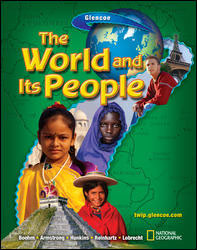
The World and Its PeopleChapter 9: The Andean CountriesChapter OverviewsColombia—named after Christopher Columbus—sits astride the Andes mountain ranges at the northwestern edge of South America. Most of Colombia's people live in the valleys and plateaus of the Andes. Petroleum, coal, gold, and emeralds are only some of the natural resources found in Colombia. Colombia's government is a republic with an elected president. Almost all of Colombia's people are mestizos—people of mixed European and Native American backgrounds. Peru and Ecuador have narrow coastal plains with mild temperatures; the high Andes in the center; and hot, rainy lowlands in the interior. Peru's largest exports are copper and fish. The Inca, a powerful Native American civilization, lived in Peru during the 1400s. The Spanish conquered the Inca in the early 1500s. Today Peruvians share a heritage from both of these groups. The Equator runs through the country of Ecuador. Ecuador also owns the Galápagos Islands, known for their rich plant and animal life. Agriculture is Ecuador's most important economic activity, and petroleum is the country's major mineral export. Bolivia is a landlocked country near the center of South America. Most Bolivians live on the altiplano, a high plateau surrounded by the Andes. Although rich in minerals, Bolivia is a poor country. Its people are mainly Native Americans or mestizos. Chile is a long, narrow country along the Pacific coast of South America. About 80 percent of Chile's land is mountainous. Mining forms the backbone of Chile's economy, but agriculture is also an important activity. |  |















